世嘉土星
body.skin-minerva .mw-parser-output table.infobox caption{text-align:center}
 | |
 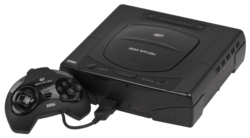 上方:日版世嘉土星後期機型 下方:美版世嘉土星初始機型 | |
| 研發商 | 世嘉 |
|---|---|
| 製造商 | 世嘉 |
| 类型 | 家用遊戲機 |
| 产品世代 | 第五世代 |
| 发布日期 |
|
| 生命週期 | 1994年-2000年 |
| 單價 | 日本:JP¥ 44,800[6] 美國:US$ 399[2] 英國:UK₤ 399.99[7] 巴西:R$ 899.99[8] 南韓:KR₩550,000[5] |
| 停產日期 |
|
| 銷售台數 | 926萬部[10] |
| 媒體 | CD-ROM、CD+G、CD+EG、Video CD、Mini CD、Photo CD |
| 電源 | AC 100 V ± 10% @ 15 W |
| 中央处理器 | 2×日立 SH-2 @ 28.6 MHz |
内存(RAM) | 2KB |
| 移動存儲 | 可擴充最多4MB |
| 顯示 | 預設解析度330×224, 最高可達704×480[6][11] |
| 图形处理器 | VDP1 & VDP2 圖像處理器 |
| 音效 | 山葉 YMF292 |
| 線上服務 | SEGA Net Link |
| 最暢銷遊戲 | 《VR快打2》(193萬份)[12] |
| 前代機種 | Mega Drive/SEGA Genesis |
| 後繼機種 | Dreamcast |
| 網站 | SEGA Saturn,存档于互联网档案馆(存檔日期 1997-03-15) |
世嘉土星(日语:セガサターン,英语:SEGA Saturn,多簡稱為SS、SAT)是日本電子遊戲商世嘉於1994年11月在日本、1995年5月在北美、1995年7月在歐洲發行的32位元次世代家用遊戲機,前代主機為Mega Drive[6][13]。主機名「世嘉土星」源自於世嘉土星為世嘉發行的第六部主機,故取名為對應的太陽系第六顆行星-土星[6]。繼任主機為Dreamcast。
世嘉土星的開發始於1992年,當時世嘉甫推出劃時代的3D街機主板SEGA Model-1。世嘉土星採用雙中央處理器架構,主機內含有兩顆日本電子公司日立製造的SH-2 32位元精簡指令集(RISC)處理器[14];世嘉土星原先只有一顆圖像處理器VDP1,但為抗衡競爭對手索尼推出的家用遊戲機PlayStation而加入另一圖像處理器VDP2,使VDP1得以專注處理3D圖形運算[13]。
世嘉土星雖然在日本獲得成功,但是在北美地區的發售由於操之過急,導致第三方遊戲開發商沒有時間為其開發遊戲,因此在3D運算技術更為先進、遊戲陣容更為豐富的PlayStation及任天堂64的影響下,世嘉土星之市占率不斷流失[15];世嘉自家招牌遊戲《音速小子》系列最新遊戲開發中止一事,也對世嘉土星造成不小的打擊[16]。最終世嘉土星於2000年全面停售,世嘉公司也因其後繼主機Dreamcast的失敗,而於隔年退出家用遊戲機硬體市場。世嘉土星在其生命週期中僅售出了926萬部[10],以商業角度來看是失敗的。
儘管有著《飛天幽夢》、《飛龍騎士》系列及《VR快打》系列等優質遊戲,世嘉土星仍因其硬體架構過於複雜、第三方遊戲陣容不足及本身商業決策錯誤而遭到抨擊。
目录
1 歷史
1.1 背景
1.2 開發
1.3 發售
1.4 世嘉的鉅變
1.5 《音速小子X-Treme》開發中止
1.6 停產
2 技術規格
2.1 硬體
2.1.1 中央處理器(CPU)
2.1.2 顯示
2.1.3 音效
2.1.4 隨機存取記憶體(RAM)
2.1.5 CD-ROM
2.2 機型
2.2.1 日本
2.2.2 北美
2.3 配件
3 遊戲陣容
4 評價
5 參見
6 參考資料
7 參考書目
8 外部連結
歷史
背景
Mega Drive(在北美地區被稱為SEGA Genesis)於1988年發售,銷售量達3075萬部,是世嘉歷年來最成功的主機[17]。1990年,時任日本世嘉總裁兼執行長中山隼雄提拔湯姆·卡林斯基為美國世嘉總裁兼執行長。卡林斯基提出了四點計畫,以提升主機銷量:降低主機價格、加強廣告宣傳、美國在地化、將《音速小子》同捆主機銷售[18][19]。日本世嘉高層起初否決此計畫[20][21],但中山隼雄認為計畫可行,並表示:「你是美國世嘉的總裁兼執行長,所以想做什麼就去做吧。」[17]結果計畫奏效,《音速小子》叫好又叫座,主機在北美的銷售量甚至一度領先競爭對手超級任天堂[22][23]。不過,為其開發的配件Mega-CD則銷量不佳[18][22]。
同時,世嘉也於街機遊戲領域獲得成功。1992年,世嘉推出劃時代的街機主板SEGA Model-1,並先後搭載由SEGA AM2部門開發的《VR賽車》及《VR快打》,首度大規模運用3D多邊形技術[13][20][23][24]。《VR快打》不僅是第一款真正的3D格鬥遊戲,還因其容易上手的操作方法及不同於傳統2D格鬥遊戲連擊系統的角色戰略系統設計而大受好評[13][25][26][27][28]。世嘉也移植了部分街機遊戲至家用遊戲機,如《VR賽車》(移植至Mega Drive)等[7],最後促成了Super 32X配件的產生[7][13][22]。
開發
世嘉土星的開發始於1992年。據時任世嘉專案經理岡村秀樹表示,主機名「世嘉土星」原先為主機之開發代號,其名取自於世嘉土星為世嘉發行的第六部主機,故取名為對應的太陽系第六顆行星世嘉土星,不過後來成為了主機正式名稱[6][13][29]。
1993年,世嘉與日本電子公司日立合作,為世嘉土星開發全新的中央處理器,即為後來的SH-2精簡指令集(RISC)處理器[6][13][26][30]。世嘉土星採用了罕見的雙處理器架構,據時任世嘉土星概念企劃人濱田和宏表示:「我們之所以會選用日立的SH-2,是因為其高效能及低成本。SH-2擁有類似於數位訊號處理器(DSP)的演算架構,不過後來我們發現單一晶片的效能無法達到對3D運算的要求。」[26][31]世嘉土星的設計於1993年底大致完成,不過在聽聞競爭對手索尼即將推出的全新家用遊戲機PlayStation抗衡PlayStation擁有較高的3D運算能力後,世嘉決定為世嘉土星再加入一個圖像處理器(即VDP2),使VDP1得以專注處理3D圖形運算[13][26][31][32]。原先世嘉打算同時發行採用CD-ROM及採用ROM卡帶兩種版本的主機,不過由於卡帶遊戲成本過高、儲存空間不足而放棄了卡帶版本[26]。
世嘉土星的架構引發世嘉高層論戰。據湯姆·卡林斯基表示,美國世嘉對世嘉土星採用雙中央處理器及圖像處理器的架構頗有微詞,「不斷反對決議」[33]。不過,卡林斯基仍在公開場合為世嘉土星的設計辯護:「我們期望將街機遊戲帶到家用遊戲機上,並試圖開發足以實現願景的架構,成果即是雙處理器設計。」[33][34]卡林斯基曾企圖找尋其他圖形處理器替代品,並與視算科技締結合作協議,不過最後遭世嘉總部駁回[35][36],視算科技則改與任天堂合作開發其次世代主機,即後來的任天堂64[35][37]。卡林斯基還曾一度與日本索尼電子出版的歐拉夫·歐拉弗森及美國索尼的米基·舒爾霍夫(Micky Schulhof)計畫開發「世嘉/索尼聯合主機」,但是由於雙方對硬體的考量分歧而破局[36][38][39]。
1993年,日本世嘉調整內部人員組織,希望為世嘉土星的發售做好準備。為了確保世嘉土星擁有高品質的3D遊戲,日本世嘉將部分街機部門人員轉為負責開發家用遊戲機遊戲。許多部門於此時成立,如開發《飛龍騎士》的AM6部門[40]。
1994年初,世嘉開始為Mega Drive開發新配件,名為Super 32X,使玩家能以較低的價格體驗32位元主機。此決議由中山隼雄提出,並受到美國世嘉的高層支持[13][22]。據時任美國世嘉開發人員斯卡特·貝利斯(Scot Bayless)表示,中山隼雄擔心若世嘉土星的發售日期過晚,使硬體發售出現空窗期,可能使世嘉的市占率遭到雅達利當時甫推出的雅達利Jaguar侵蝕[13][22]。不過後來世嘉土星的開發時程符合進度,因此,美國世嘉決定在推出世嘉土星的同時,讓Super 32X作為配件,同時也是32位元主機的入門款發售[22][41]。據時任美國世嘉研發部門負責人喬·米勒(Joe Miller)表示,由於32X的硬體架構大致與世嘉土星相同,研發32X能使開發人員熟悉世嘉土星的硬體架構[42][43]。分別由日本及美國主導的兩部主機於同一時間研發及發行的情況,使得當時的日本世嘉總部及美國世嘉情況緊張[13][22]。
發售
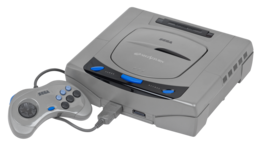
1994年推出的日版世嘉土星初始機型。
1994年11月22日,世嘉土星於日本首發,售價為44800日圓[1][13]。《VR快打》移植版作為世嘉土星的首發遊戲,於發售初期銷量幾乎與主機不相上下,間接促成主機在日本的成功[25][30][44]。由於《VR快打》的成功,日本世嘉預先準備的20萬部世嘉土星庫存銷售一空[35][44][45]。至1994年底,世嘉土星銷售量達50萬部,超越PlayStation的30萬部[39][46],並於1995年中達到一百萬部銷量[13][34]。Super 32X則於1994年11月發售,售價為世嘉土星的一半[13][37][47]。不過,32X的銷量在聖誕節旺季後即一蹶不振[13][22][41]。雖然世嘉一度領先,但是索尼以低廉的授權費用、優質的開發工具及更有彈性的銷售節奏,吸引了大量第三方廠商,使PlayStation的市佔率逐漸超越世嘉土星[43][48][49]。
1995年3月,美國世嘉宣布世嘉土星將於該年9月2日星期六(即日本的土曜日)發售[50][51]。不過,世嘉總部為與索尼抗衡,決議提早發售主機[52]。1995年5月11日,第一屆E3於洛杉磯舉辦。美國世嘉執行長湯姆·卡林斯基於發佈會中介紹世嘉土星,宣布其售價為399美元,並與《VR快打》同捆[53]。然後卡林斯基便突然表示,由於「消費者高度的渴望」[54],世嘉已準備鋪貨3萬部世嘉土星至玩具反斗城、Babbage's、電子精品及Software Etc.等零售商[2][51]。其他零售商如沃爾瑪及百思買因為未在名單中而不滿[36][55][56],KB Toys甚至將世嘉產品自其銷售列表中刪除[51]。之後索尼在宣布其主機PlayStation的價格時,其執行長史提夫·賴斯(Steve Race)僅說了一句話:「299美元。」即下台,現場掌聲不斷[36][57][58]。在歐洲,世嘉土星也比原本的預定日期提前,於1995年7月8日發售,售價為399.99英鎊[3][7]。由於發售時間出乎意料,歐洲地區的零售商和媒體沒有時間用於宣傳,因此打擊了世嘉土星的銷量[59]。在PlayStation於9月發售後,其銷量立刻超越了世嘉土星[45][46]。
世嘉花費了超過5億美元的費用,於包括電視廣告及《連線》、《花花公子》等平面雜誌上宣傳世嘉土星[34][60][61]。與前代主機SEGA Genesis的廣告相比,世嘉土星的廣告更加注重成年及專業玩家[62][63]。由於提早發售,世嘉土星的北美首發遊戲只有《VR快打》等6款,全部由世嘉自家製作,大多數的第三方遊戲都預計在世嘉土星原本的上市日期,即9月初時發行[49][53][64]。由於《VR快打》在北美人氣不高,再加上遊戲發行周期過長,抵銷了世嘉土星提早上市所帶來的好處[33][35][65]。在PlayStation於9月發售後,其銷量立刻超越了世嘉土星五個月的銷售總和,第一波的10萬部庫存全數完售[48][66]。
PlayStation初期的成功主要歸於由南夢宮推出的《實感賽車》街機移植版[46][67]。相較於世嘉的《Daytona USA》街機移植版,《實感賽車》的移植品質高出許多[51][68][69]。身為在街機市場的最大競爭對手[23][70],南夢宮同時也依據PlayStation的硬體架構,推出街機主板Namco System 11[71]。儘管在技術上不如世嘉的SEGA Model-2,但是其低成本吸引了大量小型街機商[52][71]。1994年,南夢宮挖角了大量《VR快打》的開發人員後,推出3D格鬥遊戲《鐵拳》。在前《VR快打》的設計者石井精一的主導下,《鐵拳》在各方面都超越了《VR快打》,幀率為《VR快打》的兩倍、貼圖也更細緻[72][73][74]。Playstation版本的《鐵拳》近乎完美的移植了街機原作,並成為首款銷量超過一百萬的PlayStation遊戲[52][75][76]。1995年10月,世嘉將世嘉土星的售價降為299美元[77]。同時,世嘉也將大量SEGA Model-2街機遊戲移植至世嘉土星,至1995年底已有《世嘉冠軍拉力賽車》(SEGA Rally Championship)、《VR戰警》及提升幀率至《鐵拳》等級的《VR快打2》等[78][79][80][81],其品質也普遍超越Playstation版本[7][82]。雖然世嘉土星的銷量因此而增加,但已無法挽回Playstation的決定性優勢[82][83]。至1996年,PlayStation已有世嘉世嘉土星數倍的遊戲陣容。1996年6月,世嘉土星新機型於日本發售,售價較初始機型降為199美元[84]。為此,在1996年E3上,索尼也將PlayStation的售價降為199美元[48]。儘管雙方皆持續進行價格戰,但是由於世嘉土星主機硬體製程複雜,成本不易壓低,使世嘉相對損失更大[85][86]。
世嘉的鉅變
1990年代中葉,雖然次世代主機如世嘉土星及PlayStation已經上市,但是成本相對較低的16位元家用遊戲機仍有一定市場[13];1995年,16位元家用遊戲機仍占整體遊戲機市場銷售量的64%[65][87]。由於日本世嘉低估了其16位元家用遊戲機Mega Drive/SEGA Genesis的市場潛力,並無近一步投資,因而錯失獲利機會[13][83][87]:僅1995年一年,美國世嘉就售出了2百萬部SEGA Genesis,占了整體遊戲機市場獲利的43%[83]。中山隼雄因Mega Drive在日本的銷量不佳,便決定將研發重心轉移至世嘉土星的決定,是導致世嘉錯失其16位元家用遊戲機市場獲利潛力的主要因素之一[13][88]。
「我相信中山隼雄對遊戲的熱情。我們曾討論關於開發全新遊戲硬體的事情,我非常樂意為此協助調整人事及重建世嘉,並全力發展全新的遊戲主機平台。而加入世嘉,對我來講正是一個不可多得的好機會。」
—伯尼·斯托拉爾,於1996年就任美國世嘉總裁時表示。[35]
由於與日本世嘉總部的長期分歧[35][36],湯姆·卡林斯基逐漸喪失對世嘉的信心[89]。至1996年初,已有謠傳卡林斯基決定離職[90],甚至有日本世嘉總部決定對其美國分公司進行大規模的人事調動的消息[91]。1996年7月16日,世嘉宣布,前本田董事入交昭一郎被任命為美國世嘉總裁兼執行長[9][92],而卡林斯基將在當年9月30日之後離開世嘉[66][68][93]。日本世嘉還宣布其聯合創始人大衛·羅森和現任總裁中山隼雄都將辭去現任職位,但兩人仍會留在公司中(中山隼雄並續任日本世嘉執行長)[66][94]。同時,前美國索尼電腦娛樂執行長伯尼·斯托拉爾被任命為美國世嘉負責產品研發和第三方遊戲開發者關係的執行副總裁[91]。斯托拉爾擁有豐富的交涉經驗,在索尼時曾與開發格鬥遊戲《真人快打3》的中途遊戲訂下3年的獨佔協議[95],並拉近了與藝電的關係[35],世嘉視其為重大人才,賦予重大期望[93]。
斯托拉爾認為世嘉土星的硬體設計過於複雜,不對世嘉土星抱有期待,還曾在1997年的E3上公開表示:「(世嘉)世嘉土星不是我們的未來。」[35][96]儘管如此,為了公司的整體戰略,斯托拉爾仍持續試圖為世嘉土星推出高品質遊戲[35],並表示:「為了消費者的利益,即使要(世嘉)世嘉土星退場也得慢慢地來。」[97]在索尼時,斯托拉爾曾決議將部分日本限定的PlayStation遊戲為美國本土化;在成為世嘉高層後,斯托拉爾也延續此銷售策略[35][95][70]。同時,世嘉也逐漸轉移至較為溫和的企業定位,將部分過於激進的廣告去除,並更加注重教育相關產業[65]。
在日本世嘉的戰略規劃下,部分街機部門人員轉為負責開發世嘉土星的獨佔遊戲[98]。AM2部門在負責人鈴木裕的領導下,專為世嘉土星開發獨佔遊戲。其中一款原先具有《VR快打》人物及故事背景的角色扮演遊戲,經過多次演變增改,成為了一款大型開放世界遊戲,鈴木裕視其為世嘉土星的殺手級遊戲[35][99][100]。此遊戲最終仍無法趕上世嘉土星的生命週期,後來定名為《莎木》,並於世嘉土星的後繼主機Dreamcast上發行,成為一代名作[76][101]。
《音速小子X-Treme》開發中止
由於音速小子系列的主要開發者Sonic Team正專注於《飛天幽夢》的開發[102],因此日本世嘉將開發全新3D音速小子遊戲,即《音速小子X-Treme》(Sonic X-Treme)的任務交給了位於美國的世嘉技術開發研究所。在開發Super 32X版本失敗後,開發人員決定將《音速小子X-Treme》的目標發行平台移至世嘉土星[102][103][104]。《音速小子X-Treme》將以魚眼鏡頭的形式顯示關卡,在角色移動的時候關卡也會隨之旋轉。遊戲的開發過程極為艱辛:在日本世嘉高層決定更換遊戲引擎後,開發人員被迫重新修改遊戲;為了趕上1996年底的完工期限,開發人員日以繼夜的工作,每日的工作時數甚至達到了16至20小時;雪上加霜的是,原已緩慢的開發進度還因為日本世嘉最終因為授權問題取消了開發人員對遊戲引擎的存取權而付之一炬[16][103][104]。最後在主要開發人員如奧弗·阿龍、克里斯·辛等人接連離職後,《音速小子X-Treme》於1997年初中止開發[16][103][104]。
停產
雖然自1993年起,世嘉的獲利開始隨著整體電子遊戲產業的趨勢下滑,但是仍相對維持在領導地位[61]。1996年初時,世嘉仍占有北美家用遊戲機市場的38%,領先對手任天堂的30%及索尼的24%[65]。但是,PlayStation和世嘉土星的差距愈加明顯:1995年底時,索尼在北美市場已售出80萬部PlayStation,是世嘉同時間售出之世嘉土星數量的2倍之多[105];同時,世嘉的16位元家用遊戲機Mega Drive/SEGA Genesis的銷量也開始銳減[13][65]。至1996年底,索尼總計在北美市場已售出290萬部PlayStation,大幅超越世嘉售出的120萬部世嘉土星[55]。儘管雙方皆持續進行價格戰[61],但是由於世嘉土星主機硬體製程複雜,成本不易壓低,使世嘉赤字日益嚴重[13][106]。
1996年6月,任天堂的次世代主機任天堂64發布,其飛躍性的3D運算效能,使世嘉土星原本已搖搖欲墜的銷量急轉直下[94]。1997年初,史克威爾在PlayStation平台上發行《最終幻想VII》,獲得極大成功,更對世嘉土星造成毀滅性的打擊[107]。1997年,索尼在北美市場售出的PlayStation主機數量已達世嘉售出之世嘉土星數量的3倍之多[61]。此時,索尼已占有北美家用遊戲機市場額的47%,超越了任天堂的40%及世嘉的僅僅12%,無論是降低售價還是推出任何新遊戲都已經不能扭轉世嘉土星的劣勢[9][15][94]。由於世嘉土星在北美地區的表現不佳,美國世嘉在1997年下旬資遣了60名員工[9]。
「我認為土星最大的敗筆在於其硬體架構。遊戲開發者再怎麼優秀,在那複雜的硬體架構限制之下都無法發揮全力。遊戲顯然是了不起的,但硬體並沒有達到那個水準。」
—伯尼·斯托拉爾,於2009年一次採訪中表示。[35]
由於公司財務狀況惡化,中山隼雄於1998年1月辭去日本世嘉總裁[9]。1998年3月,由於獲利不斷下降,日本世嘉自1988年在東京證券交易所上市以來,第一次遭受合併財務損失,公司合併淨虧損達356億日圓[86][108]。同時,美國世嘉宣布世嘉土星將退出北美家用遊戲機市場,以專注於其繼任者,即Dreamcast的研發[9][94]。1998年,在北美僅有12款世嘉土星遊戲推出(包括最後一款官方發行的遊戲《魔法騎士雷阿斯》),相較於1996年的116款大幅縮減[87][88][109]。日本及歐洲地區的支援則延續至2000年[110]。1998年11月,世嘉土星的後繼主機Dreamcast於日本首發[13][111]。
世嘉土星在日本銷量約575萬部、北美銷量約180萬部、歐洲銷量約100萬部、其他地區銷量約53萬部,總計約926萬部[10][112][113][114],自商業角度來看是失敗的。[110]。世嘉土星的失敗有著諸多緣由,其中最重要的是世嘉自身商業布局的失誤:在北美地區的發售由於操之過急,發售時間比原先預定早了四個月,導致第三方遊戲開發商沒有時間製作遊戲、零售商沒有時間宣傳,世嘉與零售商之間的關係因此惡化[55];再加上任天堂開發次世代主機的時程過於緩慢,最終造成索尼的PlayStation成功獲得領先地位[13][61][115]。
技術規格
硬體

世嘉土星的硬體連接概略圖[13]。

日立 SH-2
中央處理器(客製版)

山葉 YMF292
音效處理器(客製版)
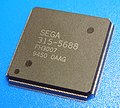
世嘉 FH3007
系統控制器
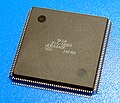
世嘉 VDP1
圖像處理器
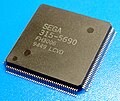
世嘉 VDP2
圖像處理器
世嘉土星主機之長、寬、高分別為260公釐×230公釐×83公釐(10.2英寸×9.1英寸×3.3英寸)[6][14][116]。
中央處理器(CPU)
世嘉土星採用雙中央處理器(CPU)設計[116][117],主機內含有兩顆由日立製造的SH-2精簡指令集(RISC)32位元微處理器,快取為4KB,每秒指令數(IPS)可達2500萬次,同時世嘉還特別將處理器頻率由20MHz超頻為28.6MHz,以符合主機實際運算需求[13][14][26][31][116]。
「多數的開發人員並沒有辦法同時活用兩顆中央處理器——大部分的遊戲最多只能使用1.5顆處理器的效能。我認為,在所有世嘉土星遊戲的開發人員中,只有大概百分之一的人能真正發揮土星的硬體潛能。」
—鈴木裕,於回顧《VR快打2》的開發時表示。[26]
SH-2處理器採用了當時最先進的乘法器技術(multiplier),使世嘉土星能實現更精確快速的幾何圖形演算。不過由於世嘉土星的兩顆SH-2處理器是使用同一匯流排存取記憶體,因此在協同運算的時候容易造成混亂;雖然世嘉土星具備一定的多元處理機能,能透過匯流排仲裁(Bus Arbitration)機能協調部分處理器運算,但是因為其複雜的硬體架構,使得開發遊戲仍十分困難,加上世嘉土星遊戲開發使用的程式語言為較困難的組合語言,世嘉也沒有提供完整的函數庫,造成大部分遊戲仍只使用單顆處理器進行運算,另一顆處理器則多只用於處理雜務[6][13][14][116][118]。
世嘉土星主機上方有一個同步動態隨機存取記憶體(SDRAM)插槽,用以擴充記憶體,提升主機運算速度。由於用以控制記憶體存取的SH-2處理器本身的機能限制,世嘉土星之記憶體最多只能擴充4MB(32Mbit)[13][14][116][119][120]。
另外在世嘉土星的光碟機中,還加入了一顆日立的SH-1微處理器作為輔助,以加快讀取速度[13][14][44][116]。
由於世嘉土星內部處理器繁多、運算架構複雜,因此世嘉引入自製的FH3007系統控制器(SCU),透過其數位訊號處理及直接記憶體存取等機能管理及協調眾多處理器元件[6][13][14][116]。
顯示
世嘉土星預設以AV端子輸出訊號,幀率最高可達每秒60幀[79][121],解析度為320×224[6][13][116](最高可達704×480[11][116][122])。世嘉土星以24位元真彩發色,同時發色數最高為1677萬色[6][13]。
世嘉土星擁有兩顆圖像處理器(GPU)(官方稱之為影像處理器(Video Display Processor,VDP)[6][7][13][14]),分別為主要負責繪製精靈圖(sprite)、貼圖(texture)及多邊形的VDP1(Video Display Processor 1)及主要負責繪製背景圖層(background)的VDP2(Video Display Processor 2)[13][14][97][122][123]。另外,世嘉土星擁有三顆也具有幾何運算能力的數位訊號處理器(DSP),兩顆位於中央處理器中,一顆則位於系統控制器中[13][14][97]。
VDP1主要負責主要負責繪製精靈圖、貼圖及多邊形等高動態物件[13][124]。身為次世代主機,世嘉土星擁有大幅超越16位元遊戲機的2D圖形運算能力,除了一般的擴大縮小、扭曲、變形、半透明、陰影等特殊顯示效果之外[6][116][122][124],還具備將2D精靈圖賦予3D座標變形處理,藉以繪製以四邊形為基礎單位之多邊形的機能,每秒最多可繪製500,000個多邊形、渲染100,000個多邊形[6][13][116][122][123][124][125]。不過,這樣的方式也顯示,世嘉土星並不是一部以3D繪圖為出發點的主機[13][123][124]。
世嘉土星原先只有一顆圖像處理器VDP1,但在開發過程中,為加強3D圖形運算能力,藉此與索尼即將推出的全新家用遊戲機PlayStation抗衡,而加入另一圖像處理器VDP2,使VDP1得以專注處理3D圖形運算[13][26][31][32][120][126]。VDP2主要負責繪製背景圖層,不過有時候也會分擔部分的前景運算工作[31][79][116][126][127]。VDP2可同時顯示最多5層圖層,並支援擴大縮小、扭曲、變形、半透明、陰影等特殊顯示效果[6][116][123][126],還可以將VDP1繪製的畫面作為單一圖層合成至訊框緩衝器(frame buffer)進一步調整,其強大的性能使世嘉土星能近乎完美的移植街機遊戲[79][116][123][126][128]。
音效
世嘉土星以摩托羅拉的客製版摩托羅拉68000微處理器為音效控制器(SCU),頻率為11.3MHz[6];音效處理器(SPU)本身則採用山葉的客製版YMF292處理器,並搭載專用的音訊數位訊號處理器FH1,頻率為22.6MHz[129],可使用頻率調變(FM,8個頻道)及脈波編碼調變(PCM,24個頻道),共計32個音訊頻道生成聲音,取樣率最高可達44.1KHz[6][97]。
隨機存取記憶體(RAM)

外接配件「擴充記憶體卡」,能增加主機可用之隨機存取記憶體。
世嘉土星擁有約2MB(16Mbit)的主記憶體、約1.5MB(12Mbit)的視訊隨機存取記憶體(VRAM)、約32KB的緊急備份用記憶體(256Kbit)及CD-ROM及音效用記憶體各約512KB(4Mbit),共計約4.5MB(36Mbit)[6][116][130][131],各自獨立運作,並透過系統控制器協調分配[116][128]。主記憶體前半由同步動態隨機存取記憶體(SDRAM)構成,主要負責遊戲本體數據及視訊畫面輸出等需要較快速度的工作;後半則由速度較慢的動態隨機存取記憶體(DRAM)構成,此部分可透過將外接配件「擴充記憶體卡」插入主機的卡帶插槽擴充。由於用以控制記憶體的SH-2處理器本身的機能限制,最多可擴充4.5MB(36Mbit),使主機記憶體最大可用容量增加至9MB(72Mbit)[6][13][116][128][132]。原先世嘉打算同時發行採用CD-ROM及採用ROM卡帶兩種版本的主機,不過由於卡帶遊戲成本過高、儲存空間不足而放棄了卡帶版本[26]。
CD-ROM
世嘉土星使用雙倍速的CD-ROM光碟機,並以日立的SH-1微處理器輔助,以加快讀取速度[13][14][44][116];光碟本身之容量為540MB[133]。另外,為了防止盜版,在遊戲光碟的最外層加入了特殊讀寫層「世嘉土星環」為防盜版機制[13][128][134]。由於為CD-ROM配置了專用記憶體,世嘉土星在運行同一款遊戲時,通常較競爭對手PlayStation流暢,畫面中斷或延遲的情形也幾乎不會出現[116][135][136]。
機型

日版世嘉土星初始機型
(HST-3200/HST-3210)

日版世嘉土星後期機型
(HST-3220)

美版世嘉土星初始機型
(MK-80000)

美版世嘉土星後期機型
(MK-80000A)
世嘉土星在其生命週期中,曾進行多次改版,世嘉也多次授權第三方廠商發行客製化版本。此外,北美版本的世嘉土星也與日本原版有著些許差異。
日本
初版世嘉土星(HST-3200)於1994年11月22日發售,售價為44800日圓;外殼為灰色,其主要辨識特徵為主機前部的左側有一個圓形的通氣口[6][13]。1995年,世嘉將世嘉土星的結構進行細微調整後重新推出(HST-3210),售價也降至34800日圓。與初代機型最大的不同是通氣口減少、電源和讀取指示燈只剩一個LED燈等[13][14]。在與PlayStation的競爭愈趨下風之後,世嘉土星再度改版,將兩個中央處理器合併於同一芯片上以節省成本,外殼也改為較廉價的白色,並於1996年3月,以初代機型售價近二分之一的20000日圓發售(HST-3220)[13][84][133][137][138]。由於對硬體規格進行了大幅縮減,新版世嘉土星失去了對部分硬體要求較高遊戲的相容性[13][116][133][137]。同時,世嘉也授權部分第三方廠商發行客製化版本,包括勝利推出的「V世嘉土星」(RG-JX1/RG-JX2)、日立推出的「Hi世嘉土星」(MMP-1/MMP-1-1/MMP-1-2/MMP-11)及專為車用導航系統製造的「遊戲&導航Hi世嘉土星」(MMP-1000NV)等[6][13][14][133][139][140]。
北美
初代北美版本的世嘉土星(MK-80000,與日版HST-3200/HST-3210機型架構相同)於1995年5月11日發售,售價為399美元[54](隨後降價至299美元[77]);整體外型延續了前代家用遊戲機SEGA Genesis的設計風格,外殼為純黑色,識別標誌也與日版有所差異,並搭配了專為北美玩家設計的控制器[7][13][33][54]。在日版世嘉土星改版後,美版隨後跟進,於1995年6月發售更新版本(MK-80000A,與日版HST-3220機型架構相同),售價也降為199美元[84];雖然內部結構大致和日版世嘉土星相同,不過整體外型改動較日版少;搭配的控制器則改為與日版相同形狀,但外觀顏色仍為黑色[84][141][142]。
配件

日版世嘉土星控制器
(HSS-0101)
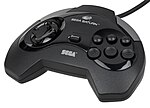
美版世嘉土星控制器
(MK-80100)

日版世嘉土星3D控制器
(HSS-0103)
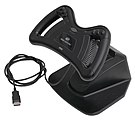
美版世嘉土星方向盤控制器
(MK-80107)

美版世嘉土星控制器擴充座
(MK-80102)
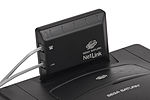
美版SEGA Net Link數據機
(MK-80118)
世嘉土星隨附的控制器之整體設計延續自前代家用遊戲機Mega Drive/SEGA Genesis的6鍵控制器,並改善十字鍵構造及控制器握感,被譽為「最適合用以遊玩2D格鬥遊戲的控制器」,在世嘉土星停產後還曾多次推出復刻版[13][133][141][143][144];此外,因應玩家需求,也研發了以紅外線與主機連線的無線版本[13][133][145][146]。初代美版世嘉土星於1995年推出時,曾特別搭配了針對北美玩家的控制器,形狀與日版控制器有些許不同[7][13][33][141];不過在世嘉土星改版後,搭配的控制器也改為與日版相同形狀[84][141][142]。後來為抗衡任天堂推出的任天堂64,在《飛天幽夢》發售後,世嘉也隨之推出附有類比搖桿的3D控制器[13][147][148];另外,還曾為不同種類的街機遊戲推出街機專業控制器(Virtua Stick)[133][149][150]、模擬飛行用控制器(Mission Stick)[133][151][152]、雙搖桿控制器(Saturn Twin-Stick)[133][153][154]及方向盤控制器(Arcade Racer Stick)[133][155][156]等。因應多人對戰遊戲如《土星轟炸超人》,世嘉還推出了6孔控制器擴充座(Multi Terminal 6),並可同時使用兩個擴充座,使得同時遊玩人數增加到最多12人[157][158][159]。
與前代家用遊戲機Mega Drive/SEGA Genesis的SEGA Channel相同,世嘉也為世嘉土星提供了線上遊戲服務SEGA Net Link。SEGA Net Link透過使用卡帶擴充槽的數據機,藉由撥接網路提供線上遊戲、閱讀電子郵件及瀏覽網路等服務[7][160][161]。由於SEGA Net Link在官方鍵盤配件發售前即上線,因此世嘉在SEGA Net Link的服務套件中附贈了內建上百個網址的光碟作為快捷連結[162]。在世嘉土星快速地退出了家用遊戲機市場的情況之下,SEGA Net Link服務僅支援《Daytona USA》、《世嘉冠軍拉力賽車》、《毀滅公爵3D》、《土星轟炸超人》及《電腦戰機》等五款遊戲[163][164]。世嘉甚至一度計畫開發內建數據機的世嘉土星機型,代號「世嘉冥王星」(SEGA Pluto),後因為世嘉土星生命週期過短而放棄研發[165][166]。
遊戲陣容
大多數世嘉土星的遊戲陣容皆為世嘉自家街機遊戲的移植版本,包括《Daytona USA》、《世嘉冠軍拉力賽車》、《電腦戰機》、《死亡之屋》、《東京番外地》、《VR戰警》系列及《VR快打》系列等[35][167][168];卡普空也為世嘉土星移植了許多格鬥遊戲,包括《快打旋風ZERO 3》、《漫威超級英雄大戰快打旋風》及《魔域幽靈3》等,皆以其完整的原作還原度而聞名[168][169]。另外,世嘉土星也有許多優質的獨佔遊戲,包括《聖龍戰記》[170]、《守護者列傳》[171][172]、《飛天幽夢》[173][174]、《光明與黑暗III》[175][176][177]、《飛龍騎士RPG》[178]及《飛龍騎士》系列等[179];部分PlayStation遊戲如《惡魔城X 月下夜想曲》、《惡靈古堡》及《磁浮飛車2097》等也有移植至世嘉土星,不過品質參差不齊[168]。由腦葉軟體開發的3D遊戲《PowerSlave》有效的將世嘉土星的3D運算能力運用至極,以致於連世嘉官方也請求他們協助開發《毀滅公爵3D》及《雷神之鎚》的世嘉土星移植版本[33][168];在知名體育遊戲開發商藝電倒戈至PlayStation陣營,加上世嘉本家為世嘉土星開發的體育遊戲並不多的情況之下[33][35][180],世嘉土星在體育遊戲陣容方面一直是大幅落後於PlayStation陣營的,不過其中還是有《棒球世界大賽》及《世嘉世界足球》系列等優質作品[33][181]。據世嘉官方統計,官方授權的世嘉土星遊戲陣容約600款,是任天堂64遊戲陣容的2倍之多[109][182]。

世嘉土星遊戲《VR戰警》的遊戲截圖。
由於《音速小子X-Treme》於1997年初中止開發的關係[16][103][104],導致世嘉土星上沒有任何獨佔的《音速小子》系列遊戲,不過仍有如《音速小子R》、《音速小子3D》及《音速小子嘉年華》等衍生遊戲及合輯發行[7][183]。世嘉企圖以全新3D遊戲《Bug!》填補空缺,不過遊戲評價兩極[184][185][186]。此外,由世嘉開發團隊Sonic Team推出的《飛天幽夢》,被視為是世嘉土星上最引人注目的3D遊戲之一;雖然不像任天堂的《超級瑪利歐64》一樣屬於全3D環境,但《飛天幽夢》以其不受拘束的角色移動方式及獨特的操作系統,向業界展示了類比搖桿及3D遊戲的潛力[187][188][189];另外一款由Sonic Team於世嘉土星生命週期後期推出的3D動作遊戲《烈火英豪》,則以其純熟的硬體半透明色運算技術運用而聞名[190][191][192]。
在美國世嘉的戰略規劃限制之下,有許多於日本聞名或銷量極佳的遊戲如《櫻花大戰》等皆從未在海外被翻譯或發行[33][35][193];其它如《冒險奇譚》、《露娜 銀河之星物語》及《生死格鬥》等遊戲雖然最初是發行在世嘉土星上,但是在海外卻只有PlayStation版本獲得翻譯[33][168][194]。許多優質的遊戲因此而被埋沒,例如《飛龍騎士RPG》雖然被稱為世嘉土星上最優秀的角色扮演遊戲,卻在世嘉土星的衰敗及美國世嘉的戰略規劃限制之下無法在海外大量發行,後來輿論甚至稱此舉為「(世嘉土星)恥辱的終沒」[191][195][196];在《光明與黑暗III》三部作品中,也只有一款遊戲在海外獲得翻譯並成功發行[177]。同時,世嘉土星也因低估了許多前代主機Mega Drive/SEGA Genesis的角色版權潛力而受到抨擊,其中又以《武士道之王》系列第三作的開發爭議最大[33][109][197]。
由於世嘉土星快速地退出了家用遊戲機市場,加上世嘉土星本身的硬體機能限制,導致《音速小子大冒險》、《莎木》、《VR快打3》及《惡靈古堡2》等知名遊戲的移植計畫最後皆轉移至世嘉土星的後繼主機Dreamcast,甚至直接付諸流水[76][198][199][200]。
評價
參見
维基共享资源中相关的多媒体资源:世嘉土星 |
- PlayStation
- 任天堂64
- 世嘉三四郎
參考資料
^ 1.01.1 [セガハード大百科] セガサターン. sega.jp. [2018-08-08]. (原始内容存档于2018-06-30).
^ 2.02.12.2 CVG UK 164.pdf - Sega Retro (PDF). segaretro.org. [2018-08-13]. (原始内容存档 (PDF)于2017-08-06) (英语).
^ 3.03.1 CVG UK 165.pdf - Sega Retro (PDF). segaretro.org. [2018-08-13]. (原始内容存档 (PDF)于2017-08-06) (英语).
^ AcaoGames BR 091.pdf - Sega Retro (PDF). segaretro.org. [2018-08-13]. (原始内容存档 (PDF)于2017-08-07) (英语).
^ 5.05.1 SPC_Saturn_Print_Ad_KR.jpg - Sega Retro. segaretro.org. [2018-08-13]. (原始内容存档于2018-08-14) (韩语).
^ 6.006.016.026.036.046.056.066.076.086.096.106.116.126.136.146.156.166.176.186.196.206.21 セガハード大百科. セガハード大百科. [2018-08-13]. (原始内容存档于2018-06-12) (日语).
^ 7.07.17.27.37.47.57.67.77.87.9 McFerran, Damien. Retroinspection: Sega Saturn. Retro Gamer: 44–49.
^ VideoGame_BR_54.pdf - Sega Retro (PDF). segaretro.org. [2018-08-13] (英语). [永久失效連結]
^ 9.09.19.29.39.49.5 Stephanie Strom. Sega Enterprises Pulls Its Saturn Video Console From the U.S. Market. The New York Times. 1998-03-14 [2018-09-15]. (原始内容存档于2013-04-30).
^ 10.010.110.2 「第11章 CESAゲームアーカイブス」『2014 CESAゲーム白書』、CESA、159頁。
^ 11.011.1 ST-103-R1-040194.pdf - Sega Retro (PDF). segaretro.org. [2018-08-13]. (原始内容存档 (PDF)于2017-08-07) (英语).
^ Sega Saturn - VGChartz. www.vgchartz.com. [2018-08-17]. (原始内容存档于2018-06-12).
^ 13.0013.0113.0213.0313.0413.0513.0613.0713.0813.0913.1013.1113.1213.1313.1413.1513.1613.1713.1813.1913.2013.2113.2213.2313.2413.2513.2613.2713.2813.2913.3013.3113.3213.3313.3413.3513.3613.3713.3813.3913.4013.4113.4213.4313.4413.4513.4613.4713.4813.49 セガハード大百科. セガハード大百科. [2018-08-12]. (原始内容存档于2018-06-12) (日语).
^ 14.0014.0114.0214.0314.0414.0514.0614.0714.0814.0914.1014.1114.12 [セガハード大百科] セガサターン 各種データ. sega.jp. [2018-08-12]. (原始内容存档于2016-08-14).
^ 15.015.1 Sega Sales Fall in First Half. Telecompaper. 1997-11-21 [2018-09-15]. (原始内容存档于2015-11-05).
^ 16.016.116.216.3 The Making Of... Sonic X-treme. Edge (Future plc). 2007-07, 15 (177): 100–103. (原始内容存档于2013-04-17) –通过Edge Online.
^ 17.017.1 Sczepaniak, John. Retroinspection: Mega Drive. Retro Gamer. 2006, (27): 42–47 [2018-08-08]. (原始内容存档于2015-09-24) (英语).
^ 18.018.1 McFerran, Damien. The Rise and Fall of Sega Enterprises. Eurogamer. 2012-02-22 [2018-09-15]. (原始内容存档于2014-02-16) (英语).
^ Kent 2001, pp. 424, 427.
^ 20.020.1 Virtua Racing – Arcade (1992). GameSpot. 2001 [2018-09-15]. (原始内容存档于2010-04-12). cf. Feit, Daniel. How Virtua Fighter Saved PlayStation's Bacon. Wired. 2012-09-05 [2018-09-15]. (原始内容存档于2014-10-14).Ryoji Akagawa: If it wasn't for Virtua Fighter, the PlayStation probably would have had a completely different hardware concept.
cf. Thomason, Steve. The Man Behind the Legend. Nintendo Power. 2006-07, 19 (205): 72.Toby Gard: It became clear to me watching people play Virtua Fighter, which was kind of the first big 3D-character console game, that even though there were only two female characters in the lineup, in almost every game I saw being played, someone was picking one of the two females.
^ Kent 2001, p. 428.
^ 22.022.122.222.322.422.522.622.7 McFerran, Damien. Retroinspection: Sega 32X. Retro Gamer. 2010, (77): 44–49.Scot Bayless: The 32X call was made in early January [1994] ... There's a part of me that wishes the Saturn had adopted the 32X graphics strategy, but that ship had sailed long before the greenlight call from Nakayama.
^ 23.023.123.2 Leone, Matt. The Essential 50 Part 35: Virtua Fighter. 1UP.com. 2010 [2018-09-15]. (原始内容存档于2012-07-19).
^ Donovan, Tristan. Replay: The History of Video Games. Yellow Ant. 2010: 267. ISBN 978-0956507204.One of the key objections to 3D graphics that developers had been raising with Sony was that while polygons worked fine for inanimate objects such as racing cars, 2D images were superior when it came to animating people or other characters. Virtua Fighter, Suzuki's follow-up to Virtua Racing, was a direct riposte to such thinking ... The characters may have resembled artists' mannequins but their lifelike movement turned Suzuki's game into a huge success that exploded claims that game characters couldn't be done successfully in 3D ... Teruhisa Tokunaka, chief executive officer of Sony Computer Entertainment, even went so far as to thank Sega for creating Virtua Fighter and transforming developers' attitudes.
^ 25.025.1 Virtua Fighter Review. Edge. 1994-12-22 [2018-09-15]. (原始内容存档于2014-12-10).Virtua Fighter 's 3D characters have a presence that 2D sprites just can't match. The characters really do seem 'alive', whether they're throwing a punch, unleashing a special move or reeling from a blow ... The Saturn version of Virtua Fighter is an exceptional game in many respects. It's arguably the first true 'next generation' console game, fusing the best aspects of combat gameplay with groundbreaking animation and gorgeous sound (CD music and clear samples). In the arcades, Virtua Fighter made people stop and look. On the Saturn, it will make many people stop, look at their bank balance and then fork out for Sega's new machine. Over to you, Sony.
^ 26.026.126.226.326.426.526.626.726.8 Sega Saturn. Next Generation. 1995-02, 1 (2): 36–43.Sega's knee-jerk reaction was to delay its Saturn development program for a few months to incorporate a new video processor into the system. Not only would this boost its 2D abilities considerably (something that Sony's machine was less proficient at), but it would also provide better texture mapping for 3D graphics ... Of course, Hitachi's link with the Saturn project goes much deeper. In 1993, the Japanese electronics company set up a joint venture with Sega to develop a CPU for the Saturn based on proprietary Hitachi technology. Several Hitachi staff were seconded to Sega's Saturn division (it's now believed that the same team is now working on preliminary 64-bit technology for Sega), and the result was the SH-2 ... As with most Sega hardware, Model 1 was basically an expensive assortment of bought-in chips. Its main CPU, an NEC V60 running at just 16 MHz, was simply too slow for the Saturn. And the bulk of Virtua Racing 's number crunching was handled by four serial DSPs that were way too costly to be included in any home system. Sega's consequent development of the SH-2 meant that it could also produce a Saturn-compatible arcade system.
^ Mott 2013, pp. 226, 250. "Virtua Racing ... was perhaps the first to treat polygons not as a graphical gimmick but as an opportunity to expand the boundaries of traditional driving games ... It's like witnessing the discovery of fire ... [Virtua Fighter] establish[ed] the template that future 3-D fighters would follow".
^ Kent 2001, pp. 501–502.
^ EGM. EGM Interviews SEGA SATURN Product Manager HIDEKI OKAMURA. EGM2. 1994-07, 1 (1): 114.Hideki Okamura: [Saturn] was just a development code name for hardware that was adopted by the Japanese development staff. The name has become common knowledge and it has a nice ring to it.
^ 30.030.1 Pollack, Andrew. Sega to Use Hitachi Chip In Video Game Machine. The New York Times. 1993-09-22 [2018-09-15].Sega Enterprises said today that it would base its next-generation home video game machine, due in the fall of 1994, on a new chip being developed by Hitachi Ltd ... One Sega official said Hitachi's chip was attractively priced and would be designed with Sega's needs in mind ... Yamaha is expected to provide sound chips and JVC the circuitry for compressing video images.
cf. Sega to add 64-Bit Processor to New Saturn System!. Electronic Gaming Monthly. 1993-12, 5 (53): 68.There are reportedly seven different processors in the Saturn. The main processor will be a custom 32-Bit RISC chip under joint development by Sega and Hitachi.
^ 31.031.131.231.331.4 NG Hardware: Saturn. Next Generation. 1995-12, 1 (12): 45–48.The early pictures and technical breakdowns have remained relatively close to the final system, perhaps because the system was completed far earlier than many people realize ... It was too late to make major alterations to the system, so, at the cost of pushing the launch schedule slightly, a video processor was added to the board to boost its 2D and 3D texture-mapping abilities. The real processing power of the Saturn comes from two Hitachi SH2 32-bit RISC processors running at 28 MHz. These processors were specially commissioned by Sega and are optimized for fast 3D graphics work.
^ 32.032.1 NG Hardware: Saturn. Next Generation. 1995-01, 1 (1): 44–45.Sega has spent the last nine months or so playing catch-up with Sony after a publisher-friend tipped Sega off about the power of PlayStation.
^ 33.0033.0133.0233.0333.0433.0533.0633.0733.0833.0933.10 Sewart, Greg. Sega Saturn: The Pleasure And The Pain. 1UP.com. 2005-08-05 [2018-09-15]. (原始内容存档于2014-03-17).
^ 34.034.134.2 Sega Saturn: You've Watched the TV Commercials...Now Read the Facts. Next Generation. 1995-08, 1 (8): 26–32.
^ 35.0035.0135.0235.0335.0435.0535.0635.0735.0835.0935.1035.1135.1235.1335.14 Fahs, Travis. IGN Presents the History of Sega. IGN: 6. 2009-04-21 [2018-09-15]. (原始内容存档于2014-03-06).
^ 36.036.136.236.336.4 Dring, Christopher. A Tale of Two E3s – Xbox vs Sony vs Sega. MCVUK.com. 2013-07-07 [2018-09-15]. (原始内容存档于2014-10-23).
^ 37.037.1 Buchanan, Levi. 32X Follies. IGN. 2008-10-24 [2018-09-15]. (原始内容存档于2016-04-17).
^ Horowitz, Ken. Interview: Tom Kalinske. Sega-16. 2006-07-11 [2018-09-15]. (原始内容存档于2009-02-07).Tom Kalinske: I remember we had a document that Olaf and Mickey took to Sony that said they'd like to develop jointly the next hardware, the next game platform, with Sega, and here's what we think it ought to do. Sony apparently gave the green light to that ... Our proposal was that each of us would sell this joint Sega/Sony hardware platform; we'll share the loss on the hardware (whatever that is, we'll split it), combine our advertising and marketing, but we'll each be responsible for the software sales we'll generate. Now, at that particular point in time, Sega knew how to develop software a hell of a lot better than Sony did. They were just coming up the learning curve, so we would have benefited much more greatly ... I felt that we were rushing Saturn. We didn't have the software right, and we didn't have the pricing right, so I felt we should have stayed with Genesis for another year.
^ 39.039.1 Japanese Stats Give Saturn the Edge. Edge. 1995-04, 3 (19): 10–11.This equates to the Saturn shifting an average number of 17,241 units a day and the PlayStation 15,789.
^ The Making Of ... Panzer Dragoon Saga Part 1. Now Gamer. 2008-12-17 [2018-09-15]. (原始内容存档于2014-07-24).Kentaro Yoshida: We thought we'd have no problem making games that were superior to PlayStation games.
^ 41.041.1 Beuscher, David. Sega Genesis 32X – Overview. Allgame. [2018-09-15]. (原始内容存档于2014-12-10).
^ Horowitz, Ken. Interview: Joe Miller. Sega-16. 2013-02-07 [2018-09-15]. (原始内容存档于2013-12-02).Joe Miller: I'd say that the rhetoric around the deteriorating relationship is probably overblown a little bit, based on what I've read. Nakayama-san and SOJ knew they had a strong, proven management team in place at SOA, and while everyone was concerned about growing the business, neither side lost confidence in the other.
^ 43.043.1 The Making Of: PlayStation. Edge: 3. 2009-04-24 [2018-09-15]. (原始内容存档于2014-10-18).
^ 44.044.144.244.3 Sega and Sony Sell the Dream. Edge. 1995-02, 3 (17): 6–9.The December 3 ship-out of 100,000 PlayStations to stores across Japan ... was not met with the same euphoria-charged reception that the Saturn received ... Saturn arrived to a rapturous reception in Japan on November 22. 200,000 units sold out instantly on day one ... Japanese gamers were beside themselves as they walked away with their prized possession and a near-perfect conversion of the Virtua Fighter coin-op ... Sega (and Sony) have proved that with dedicated processors handling the drive (the SH-1 in the Saturn's case), negligible access times are possible.
^ 45.045.1 Horsman, Mathew. Sega profits plunge as rivals turn up the heat. The Independent. 1995-11-11 [2018-09-15]. (原始内容存档于2015-01-20).
^ 46.046.146.2 Sony Computer Entertainment Inc. Business Development/Europe. SCE. [2018-09-15]. (原始内容存档于2014-07-28).
^ [セガハード大百科] スーパー32X. sega.jp. [2018-08-08]. (原始内容存档于2014-07-16).
^ 48.048.148.2 History of the PlayStation. IGN. [2018-09-15]. (原始内容存档于2012-02-18).
^ 49.049.1 Kato, Matthew. Which Game Console Had The Best Launch Lineup?. Game Informer: 3. 2013-10-30 [2018-09-15]. (原始内容存档于2017-06-30).
^ Let the games begin: Sega Saturn hits retail shelves across the nation Sept. 2; Japanese sales already put Sega on top of the charts.. Business Wire. 1995-03-09 [2018-09-15]. (原始内容存档于2014-10-25).
^ 51.051.151.251.3 Daytona USA. Edge. 1995-06, 3 (21): 72–5.Although AM2 has managed to replicate the coin-op tolerably well, Saturn Daytona fails to capture the arcade experience that PlayStation Ridge Racer so convincingly delivers.
cf. McNamara, Andy; 等. Prepare Yourself for the Ultimate Racing Experience. Game Informer. 1995-09 [2018-09-15]. (原始内容存档于1997-11-20).Daytona rules the arcade, but I think Ridge Racer dominates the home systems.
cf. Air Hendrix. Pro Review: Daytona USA. GamePro. 1995-08, 7 (73): 50.Daytona pales in comparison to Ridge Racer for the Japanese PlayStation, which takes an early lead with better features, gameplay, and graphics.
^ 52.052.152.2 Tokyo Drifter. Virtua Fight Club. GamePro. 2002-04, 14 (163): 48–50.
^ 53.053.1 Sega Saturn launch takes consumers and retailers by storm; retailers struggling to keep up with consumer demand. Business Wire. 1995-05-19 [2018-09-15]. (原始内容存档于2016-10-25).
^ 54.054.154.2 Cifaldi, Frank. This Day in History: Sega Announces Surprise Saturn Launch. 1UP.com. 2010-05-11 [2018-09-15]. (原始内容存档于2013-06-29).
^ 55.055.155.2 Schilling, Mellissa A. Technological Leapfrogging: Lessons From the U.S. Video Game Console Industry. California Management Review. 2003, 45 (3): 12, 23.Lack of distribution may have contributed significantly to the failure of the Sega Saturn to gain an installed base. Sega had limited distribution for its Saturn launch, which may have slowed the building of its installed base both directly (because consumers had limited access to the product) and indirectly (because distributors that were initially denied product may have been reluctant to promote the product after the limitations were lifted). Nintendo, by contrast, had unlimited distribution for its Nintendo 64 launch, and Sony not only had unlimited distribution, but had extensive experience with negotiating with retailing giants such as Wal-Mart for its consumer electronics products.
^ cf. Is War hell for Sega?. Next Generation. 1996-01, 2 (13): 7.Tom Kalinske: We needed to do something shocking because we were $100 more than the other guy ... I still think [the surprise launch] was a good idea. If I had it to do over again would I do it a little differently? Yeah, definitely. I wouldn't take the risk of annoying retailers the way we did. I would clue them in and do an early launch in a region or three regions or something so we could include everybody.
^ Harris 2014, p. 545.
^ Kent 2001, pp. 505, 516.
^ Dear Saturn Mag, I've Heard the Saturn Couldn't Handle Alex Kidd... Is This True?. Sega Saturn Magazine 1 (2). 1995-12: 51.
^ Sega Saturn gets astronomical send off with landmark marketing campaign; Sega breaks $50-million marketing campaign to support surprise launch at E3.. Business Wire. 1995-05-11 [2018-09-15]. (原始内容存档于2015-02-18).
^ 61.061.161.261.361.4 Mäyrä, Frans (editor); Finn, Mark. Console Games in the Age of Convergence. Computer Games and Digital Cultures: Conference Proceedings: Proceedings of the Computer Games and Digital Cultures Conference, June 6–8, 2002, Tampere, Finland. Tampere University Press. 2002: 45–58. ISBN 9789514453717.
^ Sega: Who Do they Think you Are?. Next Generation. No. 14 (Imagine Media). 1996-02: 71.
^ Sega TV: Turn On, Tune In, Buy Hardware. Next Generation. No. 14 (Imagine Media). 1996-02: 74.
^ 1995: The Calm Before the Storm?. Next Generation (Imagine Media). 1996-01, (13): 47.
^ 65.065.165.265.365.4 Gallagher, Scott; Park, Seung Ho. Innovation and Competition in Standard-Based Industries: A Historical Analysis of the U.S. Home Video Game Market. IEEE Transactions on Engineering Management. 2002-02, 49 (1): 67–82.
^ 66.066.166.2 Sega of America appoints Shoichiro Irimajiri chairman/chief executive officer. M2PressWIRE. 1996-07-16 [2018-09-17]. (原始内容存档于2014-10-18).Sega of America Inc. (SOA) Monday announced that Shoichiro Irimajiri has been appointed chairman and chief executive officer. Sega also announced that Bernard Stolar, previously of Sony Computer Entertainment America, has joined the company as executive vice president, responsible for product development and third-party business ... Sega also announced that Hayao Nakayama and David Rosen have resigned as chairman and co-chairman of Sega of America, respectively.
 需要訂閱
需要訂閱
^ Parkin, Simon. A History of Videogame Hardware: Sony PlayStation. Edge. 2014-06-19 [2018-09-15]. (原始内容存档于2014-11-29).
^ 68.068.1 Irimajiri Settles In At Sega. Next Generation. 1996-07-25 [2018-09-15]. (原始内容存档于1996-12-20).Although a familiar face at Sega of America, Shoichiro Irimajiri has spent his first week in charge re-meeting all the staff.
^ cf. Reiner, Andrew; 等. Easy Left, Baby. Game Informer. 1996-01 [2018-09-15]. (原始内容存档于1997-11-20).I'm far more impressed with this title than I was with Daytona.
cf. Top Gear. Next Generation. 1996-02, 2 (14): 160.
^ 70.070.1 Johnston, Chris. Stolar Talks Dreamcast. GameSpot. 1998-07-15 [2018-09-15]. (原始内容存档于2017-07-10).Bernie Stolar: I'm also a big believer in RPGs as well. No one ever believes that because I came out of the coin-op side of the business. But I'm an older, wiser person these days.
^ 71.071.1 Tekken. Edge. 1995-06, 3 (21): 66–70.Namco took a significant risk in basing its Tekken coin-op on raw PlayStation hardware, considering that it would be competing directly with Sega's Model 2-powered Virtua Fighter 2 ... For once, a home system can boast an identical conversion of a cutting-edge coin-op ... Namco's research section managing director, Shegeichi Nakamura ... explains: "When Sony came along we decided to go for a low-cost system—in short, we've left the big arcade stores to Sega and VF2 and Tekken has been sold to smaller arcade centres" ... Namco has a further four titles planned for System 11, all of which are likely to make the jump to the PlayStation.
^ Namco. Next Generation. 1995-01, 1 (1): 70–73.
^ Tekken. Next Generation. 1995-02, 1 (2): 82.
^ An Audience With: Katsuhiro Harada – on 20 years of Tekken and the future of fighting games. Edge. 2013-09-23 [2018-09-15]. (原始内容存档于2014-11-29).
^ cf. Scary Larry. Pro Review: Virtua Fighter. GamePro. 1995-08, 7 (73): 48.The graphics were state-of-the-art when this game was released in the arcades a year ago. Other fighters—notably Tekken and Toh Shin Den—now make better use of the polygon engine.
^ 76.076.176.2 Shenmue, the History: Our look at Shenmue's history begins back in 1996. IGN. 1999-07-13 [2018-09-15]. (原始内容存档于2014-10-30).
^ 77.077.1 Sega announces $299 Sega Saturn core pack; "Virtua Fighter Remix" pack-in available for $349.. Business Wire. 1995-10-02 [2018-09-17]. (原始内容存档于2014-05-04).Sega of America Monday announced that, effective immediately, it will dramatically drop the price of its high-end Sega Saturn system to $299.
^ cf. Reiner, Andrew; 等. Rendered and Ready to Wear. Game Informer. 1996-01 [2018-09-15]. (原始内容存档于1997-11-20). cf. Stunning. Next Generation. 1996-02, 2 (14): 162.Totally eliminates the hit or miss polarity of other light-gun games and adds a whole new level of detail to the genre.
^ 79.079.179.279.3 Virtua Fighter 2 is Here at Last!. Next Generation. [2018-09-15]. (原始内容存档于1997-04-19).[The VDP2] can generate and manipulate 3D backgrounds. This leaves the twin processors free to deal with manipulating the fighters themselves. The result is swift, elegant animation at 60 frames a second—the same speed as the VF2 coin-op ... Sony's machine does not have an equivalent of the VDP2, so the demands for better animation and more realistic movement are placing greater and greater pressure on its central processor.
^ Marriott, Scott Alan. Virtua Fighter 2. Allgame. [2018-09-15]. (原始内容存档于2014-11-14) (英语).
^ cf. Platinum Pick: Virtua Fighter 2. Next Generation. 1996-01, 2 (13): 179.The ultimate arcade translation ... the best fighting game ever.
cf. Excellent!. Next Generation. 1996-02, 2 (14): 160.A general attention to detail that sets a new mark for quality game design.
^ 82.082.1 Sony fights Sega on US streets. Next Generation. 1996-01, 2 (13): 14–16.
^ 84.084.184.284.384.4 Saturn Comes Down to Earth. Electronic Gaming Monthly (Ziff Davis). 1996-06, (83): 14–15.
^ Sony's Video Games Onslaught Continues!. Maximum: The Video Game Magazine (Emap International Limited). 1996-06, (7): 72–73.
^ 86.086.1 Sega Enterprises Annual Report 1998 (PDF). Sega Enterprises, Ltd.: 1, 7–8. [2018-09-15]. (原始内容 (PDF)存档于2004-05-04).
^ 87.087.187.2 Lemos, Robert. Sega makes play for Dreamcast support. ZDNet. 1999-03-17 [2018-09-15]. (原始内容存档于2014-12-17).
^ 88.088.1 Fahs, Travis. IGN Presents the History of Dreamcast. IGN. 2010-09-09 [2018-09-15]. (原始内容存档于2014-09-28).
^ Sega Corporation Annual Report 2000 (PDF). Sega Corporation: 18. [2018-09-15]. (原始内容 (PDF)存档于2007-09-25).
^ King, Sharon R. TECHNOLOGY; Sega Is Giving New Product Special Push. The New York Times. 1999-07-12 [2018-09-15]. (原始内容存档于2014-12-25).
^ 91.091.1 NEWSFLASH: Sega Planning Drastic Management Reshuffle – World Exclusive. Next Generation. 1996-07-13 [2018-09-15]. (原始内容存档于1996-12-20).
^ Consolidated Sales Transition by Region (PDF). Nintendo. [2018-09-15]. (原始内容 (PDF)存档于2010-02-14).
^ 93.093.1 Kalinske Out – WORLD EXCLUSIVE. Next Generation. 1996-07-16 [2018-09-15]. (原始内容存档于1996-12-20).
^ 94.094.194.294.3 Day, Rebecca. Battle of the Games. Popular Mechanics. 1996-12, 173 (12): 52.
^ 95.095.1 Kent 2001, p. 506.
^ 「セガサターン」はなぜ失敗したのか?当時のCEOが語る. Gigazine. 2018-09-15. (原始内容存档于2018-06-12) (日语).
^ 97.097.197.297.3 Saturn Overview Manual. Sega of America. 1994-06-06.
^ Kolan, Patrick. Shenmue: Through the Ages. IGN. 2007-08-07 [2018-09-15]. (原始内容存档于2014-11-04).
^ The Making of Shenmue: Yu Suzuki on the Cult Classic's Genesis, Development—And Its Future. Edge. 2014-03-20 [2018-09-15]. (原始内容存档于2014-12-15).
^ Corriea, Alexa Ray. Creator Yu Suzuki shares the story of Shenmue's development. Polygon. 2014-03-19 [2018-09-15]. (原始内容存档于2015-06-28).
^ The official development system. Edge. 1995-08, 3 (23): 55.
^ 102.0102.1 Horowitz, Ken. Developer's Den: Sega Technical Institute. Sega-16. 2007-06-11 [2018-09-15]. (原始内容存档于2016-04-08).Roger Hector: When it became obvious that Sony was taking the lead, Sega's corporate personality changed. It became very political, with lots of finger-pointing around the company. Sega tried to get a handle on the situation, but they made a lot of mistakes, and ultimately STI was swallowed up in the corporate turmoil.
^ 103.0103.1103.2103.3 Fahs, Travis. Sonic X-Treme Revisited – Saturn Feature at IGN. IGN. 2008-05-29 [2018-09-15]. (原始内容存档于2017-07-12).
^ 104.0104.1104.2104.3 Houghton, David. The greatest Sonic game we never got .... GamesRadar. 2008-04-24 [2018-09-15]. (原始内容存档于2013-05-21).
^ McCarthy, Dave. PlayStation-The total history. Eurogamer. 2006-11-20 [2018-09-15]. (原始内容存档于2014-11-29).
^ 西田宗千佳『美学vs.実利 「チーム久夛良木」対任天堂の総力戦15年史』講談社、2008年、pp.114-115
^ The Making Of: Final Fantasy VII. Edge: 3. 2012-08-26 [2018-09-15]. (原始内容存档于2014-10-26).
^ Sega News From Japan. GameSpot. 1998-03-18 [2018-09-15].
^ 109.0109.1109.2 Parish, Jeremy. The Lost Child of a House Divided: A Sega Saturn Retrospective. USgamer. 2014-11-17 [2018-08-21].
^ 110.0110.1 Lefton, Terry. Looking for a Sonic Boom. Brandweek. 1998, 9 (39): 26–29.
^ Saturn Gets Hooked Up. Electronic Gaming Monthly (Ziff Davis). 1996-05, (82): 20.
^ Goodbye (?!) Sega Saturn. Dreamcast Magazine (JP). 2000-04-07, 3 (12): 154.
^ Zackariasson, Peter; Wilson, Timothy L.; Ernkvist, Mirko. Console Hardware: The Development of Nintendo Wii. The Video Game Industry: Formation, Present State, and Future. Routledge. 2012: 158. ISBN 978-1138803831.
^ Weekly Famitsu Express. Famitsu. 1996-06-21, 11 (392): 8.
^ DeMaria & Wilson 2004, pp. 282–283.
^ 116.00116.01116.02116.03116.04116.05116.06116.07116.08116.09116.10116.11116.12116.13116.14116.15116.16116.17116.18116.19 Sega Saturn hardware notes (2004-04-27) - Sega Retro. segaretro.org. [2018-08-13]. (原始内容存档于2018-08-14) (英语).
^ Beuscher, Dave. Sega Saturn – Overview. Allgame. [2018-09-15]. (原始内容存档于2014-11-14).
^ Kent 2001, p. 509. "In theory, Saturn, which featured two Hitachi SH2 32-bit central processing chips, was more powerful than PlayStation. The truth was that the SH2 chips were somewhat inferior to the chip Sony had selected ... and allotting different operations to both of the processing chips proved nearly impossible".
^ セガのハードに込められた熱意が語られた GAME ONトークイベント“セガハードの歴史を語り尽くす”詳細リポート. ファミ通. 2016-06-03. (原始内容存档于2018-06-13) (日语).
^ 120.0120.1 中 裕司がアツく語った『ソニック』『大魔界村』そしてメガドラ愛。幻のメガドラタイトルのお披露目も!?【ゲームセンターCX放送作家の「いまさらメガドラ計画」】第2回. 電ファミニコゲーマー. 2016-07-07. (原始内容存档于2018-06-12) (日语).
^ ST-013-R3-061694.pdf - Sega Retro (PDF). segaretro.org. [2018-08-13]. (原始内容存档 (PDF)于2018-08-14) (英语).
^ 122.0122.1122.2122.3 VDP1 User Manual. Sega of America: 134. 1995-06-27.
^ 123.0123.1123.2123.3123.4 Musashi, Joe Shinobi. Sega Saturn 3D Capabilities | Shin Force > Information. www.shinforce.com. [2018-08-13]. (原始内容存档于2017-10-21).
^ 124.0124.1124.2124.3 VDP1 - Sega Retro. segaretro.org. [2018-08-13]. (原始内容存档于2017-10-04) (英语).
^ Interview: Ezra Dreisbach. Curmudgeon Gamer. 2002-07-09 [2018-09-15]. (原始内容存档于2007-09-27).Ezra Dreisbach: And really, if you couldn't tell from the games, the PSX is way better than the Saturn. It's way simpler and way faster. There are a lot of things about the Saturn that are totally dumb. Chief among these is that you can't draw triangles, only quadrilaterals.
^ 126.0126.1126.2126.3 VDP2 - Sega Retro. segaretro.org. [2018-08-14]. (原始内容存档于2017-10-03) (英语).
^ Saturn Technical Specs. Next Generation. [2018-09-15]. (原始内容存档于1996-12-20).
^ 128.0128.1128.2128.3 セガサターン. Wikipedia. 2018-08-06 (日语).
^ Day, Rebecca. Battle of the Games. Popular Mechanics. 1996-12, 173 (12): 52.
^ Sega Service Manual - Sega Saturn (PAL) - 013-1 - June 1995.pdf - Sega Retro (PDF). segaretro.org. [2018-08-13]. (原始内容存档 (PDF)于2018-08-14) (英语).
^ 13-APR-94.pdf - Sega Retro (PDF). segaretro.org. [2018-08-13]. (原始内容存档 (PDF)于2017-08-06) (英语).
^ HM514260C datasheet.pdf - Sega Retro (PDF). segaretro.org. [2018-08-13]. (原始内容存档 (PDF)于2017-08-06) (英语).
^ 133.0133.1133.2133.3133.4133.5133.6133.7133.8133.9 セガハード大百科. セガハード大百科. [2018-08-14]. (原始内容存档于2018-07-11) (日语).
^ 20年以上の時を超えてセガサターンをクラックした猛者が登場. GIGAZINE. [2018-08-13]. (原始内容存档于2018-08-14) (日语).
^ HM514260 datasheet.pdf - Sega Retro (PDF). segaretro.org. [2018-08-13]. (原始内容存档 (PDF)于2018-08-14) (英语).
^ mamedev/mame. GitHub. [2018-08-13] (英语).
^ 137.0137.1 [セガハード大百科] セガサターン. sega.jp. [2018-08-14]. (原始内容存档于2018-08-14).
^ Hunter, Yasuhiro. Sega Reveals a New Saturn!!!. Maximum: The Video Game Magazine (Emap International Limited). 1996-05, (6): 127.
^ ポータブルマルチメディアプレーヤー 「ゲーム&カーナビ ハイサターン」を発売. [2018-09-17]. (原始内容存档于2018-03-31).
^ On the Move!. Sega Saturn Magazine 2 (4). 1996-02: 9.
^ 141.0141.1141.2141.3 Control Pad - Sega Retro. segaretro.org. [2018-08-14]. (原始内容存档于2018-08-14).
^ 142.0142.1 Press release: 1996-09-17: Sega brings fun and games, ease-of-use to TV Internet market - Sega Retro. segaretro.org. [2018-08-14]. (原始内容存档于2017-09-18) (英语).
^ [セガハード大百科] セガサターンコントロールパッド. sega.jp. [2018-08-15]. (原始内容存档于2016-07-10).
^ The Sega Saturn Controller: Greatest, Or Merely Bestest?. VentureBeat. 2010-04-14 [2018-08-15] (美国英语).
^ [セガハード大百科] セガサターンコードレスパッド. sega.jp. [2018-08-15]. (原始内容存档于2016-05-14).
^ Saturn Infrared Control Pad. Sega Retro. [2018-08-15]. (原始内容存档于2017-11-24) (英语).
^ 3D Control Pad. Sega Retro. [2018-08-15]. (原始内容存档于2018-04-10) (英语).
^ Buy Nights Into Dreams... with 3D Control Pad Sega Saturn Store | United States of America | 81048 | Best Deals at the Lowest Price. www.satakore.com. [2018-08-15]. (原始内容存档于2016-08-07) (英语).
^ [セガハード大百科] バーチャスティック. sega.jp. [2018-08-15]. (原始内容存档于2016-07-10).
^ Virtua Stick. Sega Retro. [2018-08-15]. (原始内容存档于2018-06-04) (英语).
^ [セガハード大百科] アナログミッションスティック. sega.jp. [2018-08-15]. (原始内容存档于2016-07-10).
^ Mission Stick. Sega Retro. [2018-08-15]. (原始内容存档于2014-08-02) (英语).
^ [セガハード大百科] ツインスティック. sega.jp. [2018-08-15]. (原始内容存档于2016-07-10).
^ Saturn Twin-Stick. Sega Retro. [2018-08-17]. (原始内容存档于2017-10-11) (英语).
^ [セガハード大百科] レーシングコントローラ. sega.jp. [2018-08-15]. (原始内容存档于2016-09-24).
^ Arcade Racer Joystick. Sega Retro. [2018-08-17]. (原始内容存档于2017-11-23) (英语).
^ Protos: Bomberman. Electronic Gaming Monthly. No. 92 (Ziff Davis). 1997-03: 34.
^ Six Packed. GamePro (IDG). 1995-10, (85): 154.
^ [セガハード大百科] マルチターミナル6. sega.jp. [2018-08-17]. (原始内容存档于2016-03-03).
^ [セガハード大百科] セガサターンモデム. sega.jp. [2018-08-17]. (原始内容存档于2016-03-03).
^ Internet Access, Network Games Hit Saturn - For Less than $400. Electronic Gaming Monthly (Ziff Davis). 1996-07, (84): 18.
^ Saturn to Get Internet Connection Facilities in '96!. Sega Saturn Magazine 2 (5). 1996-03: 8.
^ Mott 2013, p. 309.
^ Redsell, Adam. SEGA: A Soothsayer of the Games Industry. IGN. 2012-05-20 [2018-09-17]. (原始内容存档于2013-10-12).
^ Is War Hell for Sega?. Next Generation (Imagine Media). 1996-01, (13): 9.Sega of Japan recently announced it was going to produce a Saturn with Internet access built in.
^ Blagdon, Jeff. Forgotten Sega Pluto console prototype surfaces online (update). The Verge. 2013-04-17 [2018-09-17]. (原始内容存档于2014-03-22).
^ House, Michael L. The House of the Dead Review. Allgame. [2018-08-21]. (原始内容存档于2014-11-14).
^ 168.0168.1168.2168.3168.4 Best Saturn games of all time. GamesRadar. 2014-03-06 [2018-08-21].But that doesn't mean it's a total bust. Numerous excellent games were released for the console, which was supported primarily in the mid-to-late 1990s, including a variety of original Sega classics and several stellar third-party releases. RPG and fighting game fans, in particular, enjoyed a healthy array of options on the platform.
^ SEGA Saturn is number 18. IGN. [2018-08-21].
^ Dragon Force for Saturn. GameRankings. [2018-08-21].
^ Guardian Heroes for Saturn. GameRankings. [2018-08-21].
^ Mott 2013, p. 300.
^ Nights Into Dreams for Saturn. GameRankings. [2018-08-21].
^ Mott 2013, p. 302.
^ Shining Force III for Saturn. GameRankings. [2018-08-21].
^ Shining creators Hiroyuki Takahashi and Shugo Takahashi have named Shining the Holy Ark and Shining Force 3 their favorite games in the series. See Power Profiles: Takahashi Brothers. Nintendo Power. 2008-08, 21 (229): 80–83.
^ 177.0177.1 Mott 2013, p. 350.
^ Panzer Dragoon Saga for Saturn. GameRankings. [2018-08-21]. cf.Panzer Dragoon Saga. Game Informer. 1998-05-15 [2018-08-21]. (原始内容存档于1999-08-24).Only Final Fantasy VII tops it.
cf. Panzer Dragoon Saga Review. Edge. 1998-03-25 [2018-08-21]. (原始内容存档于2014-12-24).Adds a creative depth only SquareSoft games can currently rival.
cf. Panzer Dragoon Saga. Next Generation. 1998-05-14 [2018-08-21]. (原始内容存档于1999-08-29).One of the best RPGs ever.
^ Panzer Dragoon II Zwei for Saturn. GameRankings. [2018-08-21].
^ Kent 2001, p. 533.
^ cf. Sega Sports Does It One More Time. Game Informer. 1995-11 [2018-08-21]. (原始内容存档于1999-08-24).World Series Baseball is by far the smoothest baseball game ever made.
cf. Worldwide Soccer '98. Game Informer. 1998-01 [2018-08-21]. (原始内容存档于1999-09-30).The graphics are smooth, and the physics are perfect.
^ [セガハード大百科] セガサターン専用ソフトの一覧. セガハード大百科. [2018-08-21] (日语).
^ Sonic 3D Blast. Game Informer. 1997-01 [2018-08-21]. (原始内容存档于1997-10-21).
^ Bug! for Saturn. GameRankings. [2018-08-21]. cf. McNamara, Andy. Not To Be Denied!. Game Informer. 1995-09 [2018-08-21]. (原始内容存档于1997-11-20). cf. Bug! (review). Electronic Gaming Monthly. 1995-08, 7 (73): 38.
^ Buchanan, Levi. What Hath Sonic Wrought? Vol. 10. IGN. 2009-02-02 [2018-08-21].Steven Spielberg, CES 1995: This is the character! This is the character that is going to do it for Saturn!
^ Bug!. Next Generation. 1995-09, 1 (9): 88–89.
^ Nights into Dreams (review). Edge. 1996-08-02 [2018-08-21]. (原始内容存档于2014-12-24). cf. Nights Into Dreams Retrospective. Edge. June 8, 2007 [2018-08-21]. (原始内容存档于2014-10-31). cf. Retrospective: Nights Into Dreams. Edge. 2014-03-15 [2018-08-21]. (原始内容存档于2014-10-06).The 3D environments were drawn by one processor, while another handled the 2D enemies, hoops and trees, melding them seamlessly to create a smooth, surprisingly fast-moving game that still looks striking today.
^ Buchanan, Levi. Nights into Dreams Retro Review. IGN. 2008-08-18 [2018-08-21].
^ Robinson, Martin. Nights Into Dreams HD review. Eurogamer. 2012-05-10 [2018-08-21].
^ Classic Reviews: Burning Rangers. Game Informer. 2002-06, 12 (110): 104.This futuristic fire-fighting game was an instant cult classic ... The game has all the makings of a masterpiece, but is held back by both the Saturn's limited power and the fireman motif.
^ 191.0191.1 Buchanan, Levi. Burning Rangers Retro Review. IGN. 2008-09-03 [2018-08-21].A wholly competent (but somewhat workmanlike, as the Saturn was not as good at 3D as the PSone or N64) action-adventure game.
^ Mott 2013, p. 353.
^ cf. Japan Votes on All Time Top 100. Edge. 2006-03-03 [2018-08-21]. (原始内容存档于2014-10-10).
^ cf. Catching up with Tecmo's Prince of Darkness. Game Informer. 2004-12, 15 (140): 203.Tomonobu Itagaki: Saturn was a great machine, great system. If someone were to ask me if I want to make a game for PSone or Saturn I would—100 percent of the time—make games for the Saturn.
^ Panzer Dragoon Saga: The Sad Tale of the Saturn's Last Great Game. Game Informer. 2007-12, 17 (176): 164–165.One of the greatest games ever crafted by human hands ... Critically, the game was a smash hit, lauded as one of the year's best, and generally considered the Saturn's finest title. But despite glowing reviews across the board, Saga was destined to fail. Sega had moved on—shifted its focus to developing its next console, the Dreamcast, and wasn't willing to risk any more money on a system that had already lost so much. Therefore, less than 20,000 retail copies of Panzer Dragoon Saga were even made, making it a very rare title and a prize for collectors.
^ Mott 2013, p. 361.
^ The History of Sega Fighting Games. GameSpot: 11. [2018-08-21]. (原始内容存档于2009-05-17). ; The History of Sega Fighting Games. GameSpot: 12. [2018-08-21]. (原始内容存档于2009-05-17).
^ Ohbuchi, Yutaka. RE2 for Saturn Canceled. GameSpot. 1998-10-21 [2018-08-21]. (原始内容存档于2014-11-10).
^ Suzuki: 'Yes on VF3'. Next Generation. 1996-11-22 [2018-08-21]. (原始内容存档于1996-11-20).
^ The History of Sega Fighting Games, Page 18. GameSpot. [2018-08-21]. (原始内容存档于2009-05-17).Sega executives started to quietly state that Virtua Fighter 3 was not going to come out for the Saturn.
參考書目
Mott, Tony. 1001 Video Games You Must Play Before You Die. New York, New York: Universe Publishing. 2013. ISBN 978-0-7893-2090-2.
Harris, Blake J. Console Wars: Sega, Nintendo, and the Battle That Defined a Generation. New York, New York: HarperCollins. 2014. ISBN 978-0-06-227669-8.
DeMaria, Rusel; Wilson, Johnny L. High Score!: The Illustrated History of Electronic Games. Emeryville, California: McGraw-Hill/Osborne. 2004. ISBN 0-07-223172-6.
Kent, Steven L. The Ultimate History of Video Games: The Story Behind the Craze that Touched our Lives and Changed the World. Roseville, California: Prima Publishing. 2001. ISBN 0-7615-3643-4.
外部連結
官方网站 (日文)
舊版世嘉硬體大百科(日文)
新版世嘉硬體大百科(日文)
SEGA Retro(英文)
| |||||||||||||||||||||||||||||||||||||
| ||||||||||
| ||||||||||||||||||||||||||||||||||||||||||||||||||||||||||||||||














